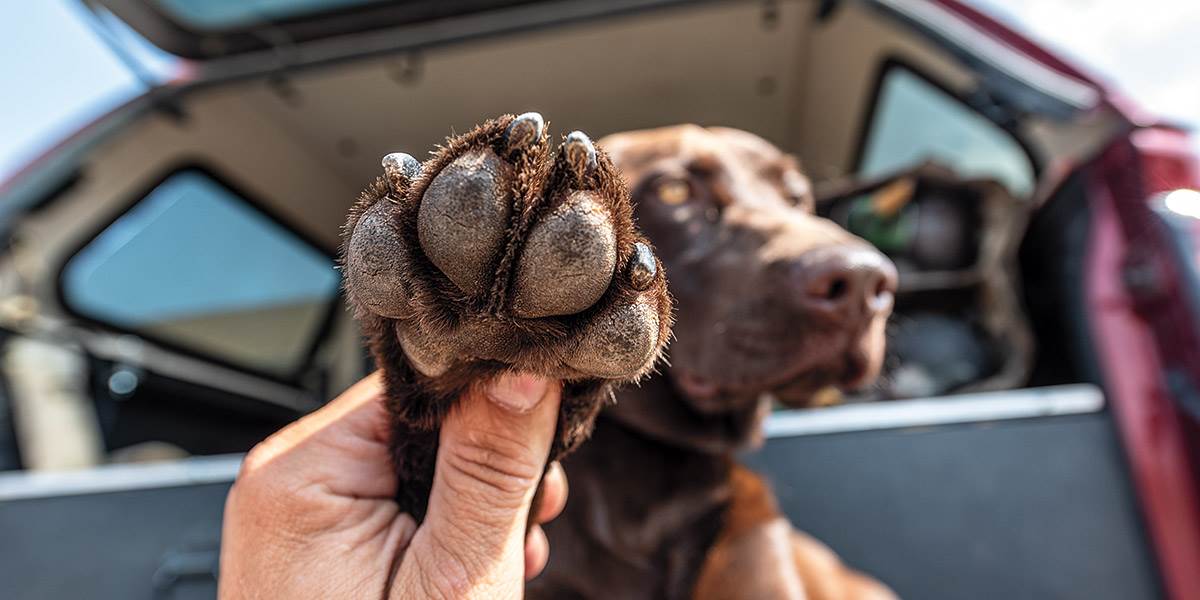Healthy Feet
Taking good care of your dog's paws will help him perform at his peak
Taking good care of your dog's paws will help him perform at his peak

A dog's feet are his physical connection to the environment where the rubber meets the road, as they say. If your retriever's feet are not in tip-top condition, his ability to perform is bound to be compromised.
Perhaps the most basic element of canine foot care is keeping the toenails properly trimmed. Dr. Jennell Appel, proprietor of the Georgia-based SportVet Canine Rehabilitation and Sports Medicine Clinic, says, "It's important to understand the growth rate of your dog's nails. Some dogs don't need their nails trimmed more than once a month, while other dogs' nails grow like weeds."
It's important to recognize that the "quick"—the living, blood- and nerve-supplied center of the toenail—grows as the nail's outer shell does. So, the longer you allow that nail to grow, the harder it becomes to trim it to the proper length without cutting into the quicka painful and bloody slipup that could make your dog even more averse to nail trimming than he already might be. Trimming black nails is especially precarious because the quick isn't visible like it is in a white nail, but the guards on many of today's trimmers help you do it without hurting the dog.
Appel prefers a sturdy scissors-style trimmer and adds that a Dremel tool, or even a good-quality nail file, can be used to smooth down any rough or sharp edges. She notes that this is especially important with older dogs, whose nails are typically more brittle and more prone to cracking and splintering.
With regard to pad care, the biggest issue Appel sees is associated with hunting in dry environments. "When the ground is hot, dry, and cracked," she explains, "the pads become the same way very quickly. The product I love for preventing this is called Musher's Secret. You rub it into the pads at the end of the day and it keeps them moist and supple. You should wait to use it, though, until after the pads have roughened up a little. You don't want the pads to become too soft too soon."
.jpg)
A foot injury could sideline your retriever. Check his paws after every hunt and trim his nails regularly.
For treating cuts to pads in the field, Appel's go-to is a layer of superglue applied directly to the wound followed by a post-hunt soak in Epsom salts and warm water. For pads that are scraped or abraded, she recommends a topical antibacterial such as Neosporin in combination with a chlorhexidine-based antiseptic solution.
In terms of assessing the severity of a pad injury, Appel says, "My rule of thumb is that superficial lacerations, meaning wounds that don't go all the way through to the meat of the pad tissue, are issues you can treat yourself. But if you can see the white tissue beyond the paw pad, you're looking at something that requires a trip to the veterinarian, probably for suturing."
Appel emphasizes that any inflammation or swelling, between the pads in particular, is something that needs to be addressed as soon as possible. "If you don't get on top of it quickly," she explains, "it can lead to a bone infection. You need to have it looked at by a veterinarian and, whatever you do, don't try to lance it yourself. There are numerous small ligaments and tendons near the toes that are very easy to damage if you don't know what you're doing."
Appel strongly recommends trimming the hair on the feet of long-haired dogs to reduce the risk of foreign matter collecting between the pads and potentially penetrating the skin. Be alert for grass awns—the barbed seed heads of certain grasses—which can work their way into a dog's paw, migrate up the leg, and lodge in the chest, where their impact can be devastating. "You should get in the habit of checking the paw pads at the end of every hunt and cleaning out any debris," Appel says. "It can be a lifesaver."
Appel adds this final note: "If your dog has a foot problem, don't pass it off as just a foot issue. As we who work in canine rehabilitation and sports medicine like to say, there is no such thing as minor' lameness. A problem with gait, whether it's associated with the foot or somewhere farther up the leg, is always something that needs to be addressed."
Ducks Unlimited uses cookies to enhance your browsing experience, optimize site functionality, analyze traffic, and deliver personalized advertising through third parties. By continuing to use this site, you agree to our use of cookies. View Privacy Policy